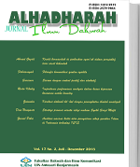KOMUNIKASI KEBERAGAMAN TENTANG MAKNA UCAPAN SALAM OM SWASTIASTU ANTAR UMAT BERAGAMA
DOI:
https://doi.org/10.18592/alhadharah.v19i1.3859Keywords:
Komunikasi, Dakwah Budaya, MilenialAbstract
This research is motivated by the phenomenon of the pros and cons of greeting Om Swastiastu among officials. The purpose of this study is to find and explain more deeply about the motives, experiences and meaning of Om Swastiastu's greetings for communication between religions. The research method used in this research is the phenomenology method. While the data collection techniques used are non-participant observation, in-depth interviews, literature study and documentation. The subjects of this study were government officials or apparatuses who said Om Swastiastu greeting, amounting to 7 people and taking informants using purposive sampling. The results showed that the future motives (in order motive) greetings from Om Swastiastu were self existence and tolerance and motives from the past (because motive) greetings from Om Swastiastu were due to internal encouragement, the spirit of nationality, a sense of nationalism and the principle of neutrality. While the experience of saying Om swastiastu greetings is divided into pleasant experiences (positive), that is feeling valued, getting new political relations, good treatment, sympathy and growing solidarity between people while the unpleasant experience (negative) is mandating unfavorable treatment, derision in the form of harsh words, criticism and stay away from and considered to have no stance. While the meaning of Om swastiastu's greetings is to pray for salvation in the Hindu version, a word of thanksgiving and a greeting.References
Aisyah, Siti. (2013). Pola Komunikasi Antar Umat Beragama (Studi
Komunikasi Antarbudaya Tionghoa dengan Muslim Pribumi di Rw
Kelurahan Mekarsari Tangerang. Jakarta: Universitas Islam
Syarif Hidayatulloh.
Aga, Bali. (2006). Ragam Istilah Hindu. Denpasar: Tim Bali Aga.
Bungin, Burhan. (2010). Metodologi Penelitian Kualitatif. Jakarta: Rajawali Pers.
Gerungan. (2010). Psikologi Sosial. Bandung: PT.Refika Aditama.
Hermawan, Awan. (2010). Komunikasi Antar Umat Berbeda Agama.
Jurnal Komunikasi Dan Realitas Sosial.Volume 1 No 1.
Husaini, Adian. (2006). Pluralisme agama: Parasit bagi Agama-agama.
Jakarta: Dewan Da’wah Islamiyah Indonesia.
Komarudin, Acep. (2015). Pemahaman Hadist Larangan Mengucapkan
dan Menjawab Salam Terhadap Non Muslim. Jakarta: Universitas
Islam Syarif Hidayatulloh.
Kuswarno, Engkus. (2013). Fenomenologi Konsepsi, Pedoman dan Contoh
Penelitian. Widya Padjajaran.
Salam, Abdus. (2017). Sebarkan Salam, Kiat Mudah Menjaga Kasih sayang
dan Ukhuwah. Depok: Pustaka Khazanah Fawa’id.
Wiadnyana, Agus. (2013). Istilah Hindu, Perbendaharaan Kata dalam Kitab Smrti Veda dan Nama-nama Dewata Hindu. Gianyar: Gandapura.
Yahya, Ahmad Syarif. (2017). Ngaji Toleransi. Jakarta: Gramedia.
Downloads
Published
How to Cite
Issue
Section
License
Authors retain copyright and grant the journal the right of first publication, with the work simultaneously licensed under the Creative Commons Attribution-NonCommercial 4.0 International Public License (CC BY-NC 4.0). This license allows reusers to distribute, remix, adapt, and build upon the material in any medium or format for noncommercial purposes only, provided that proper attribution is given to the original creator.







